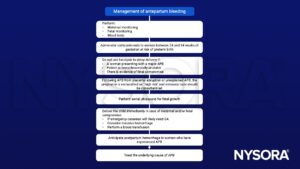Learning objectives
- Definition of antepartum bleeding (APB)
- Causes and consequences of APB
- General management of APB
Definition and mechanisms
- Antepartum bleeding (APB) is defined as bleeding from the genital tract after 24 weeks of gestation and before the birth of the baby
- A relatively frequent problem, occurring in 5% to 6% of pregnant women
- It remains a major cause of perinatal mortality and maternal morbidity
- Four degrees of APB:
- Spotting: stains, streaking, or spotting of blood
- Minor hemorrhage: < 50 mL
- Major hemorrhage: 50-1000mL without signs of circulatory shock
- Massive hemorrhage: > 1000mL with or without signs of circulatory shock
Causes
- Cervicitis
- Placenta abnormalities
- Abruptio placentae
- Placenta previa
- Placenta accreta /increta/percreta
- Uterine rupture
- Vasa previa
- Amniotic fluid embolism
Complications
| Maternal complications | Fetal complications |
|---|---|
| Perioperative anemia Infection Maternal shock Renal tubular necrosis Consumptive coagulopathy Postpartum hemorrhage Prolonged hospital stay Psychological sequelae Complications of blood transfusion | Fetal hypoxia Small for gestational age and fetal growth restriction Prematurity (iatrogenic and spontaneous) Fetal death |
Management

Suggested reading
- Walfish, M., Neuman, A., Wlody, D., 2009. Maternal haemorrhage. British Journal of Anaesthesia 103, i47–i56.
- Mercier FJ, Van de Velde M. Major obstetric hemorrhage. Anesthesiol Clin. 2008;26(1):53-vi.
- Antepartum haemorrhage Green–top Guideline No. 63 November 2011 royal College of obstreticans and gynaecologists. https://www.rcog.org.uk/media/pwdi1tef/gtg_63.pdf
We would love to hear from you. If you should detect any errors, email us [email protected]







